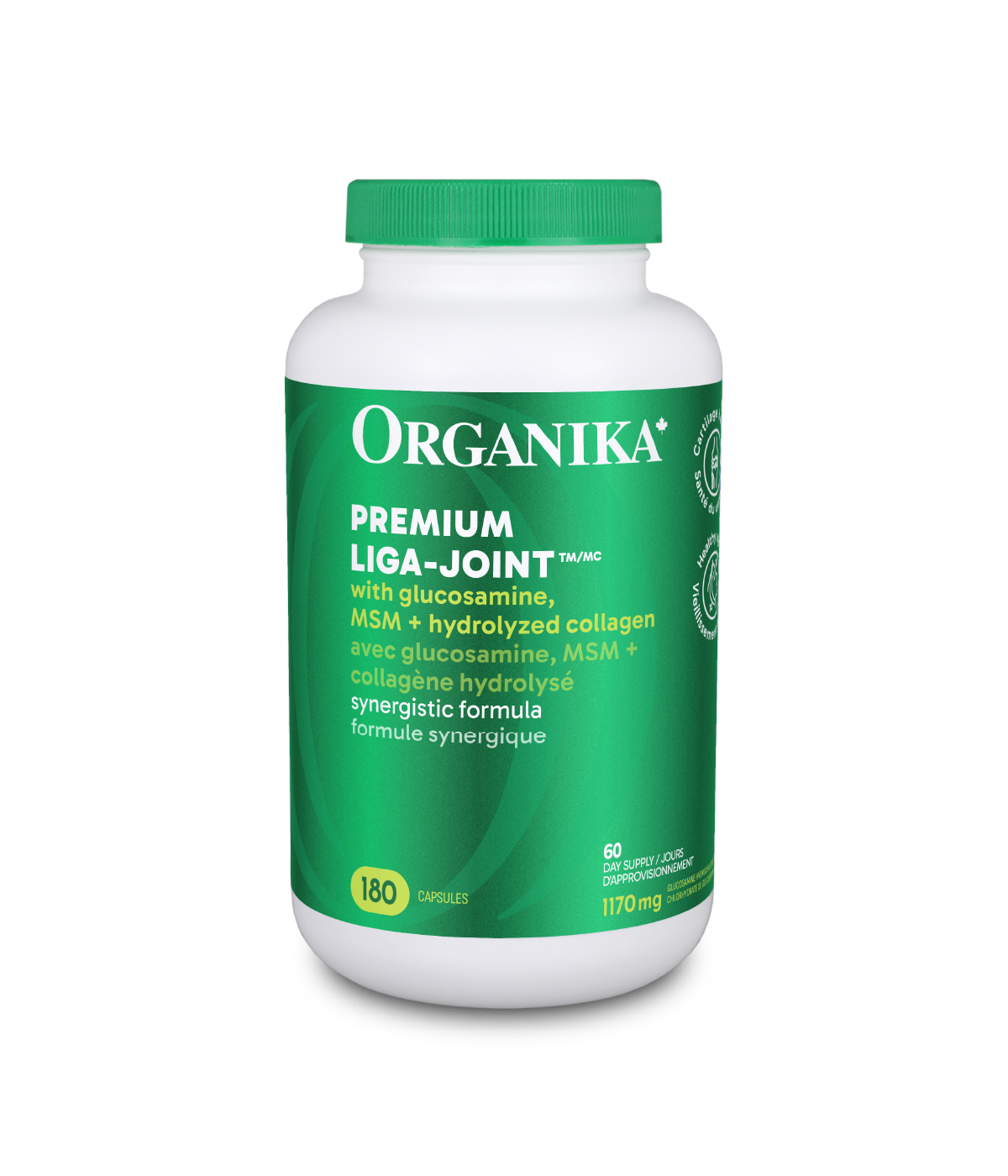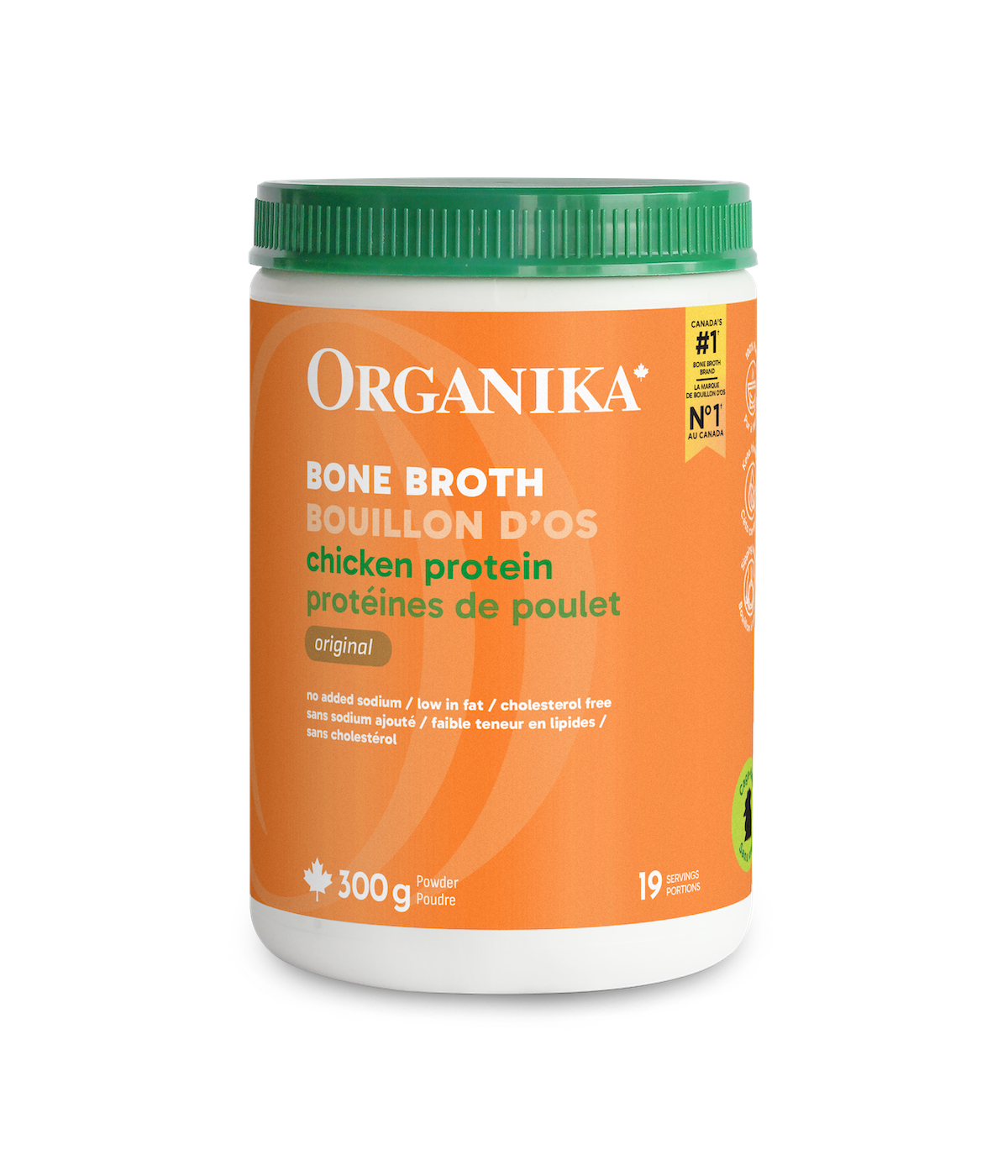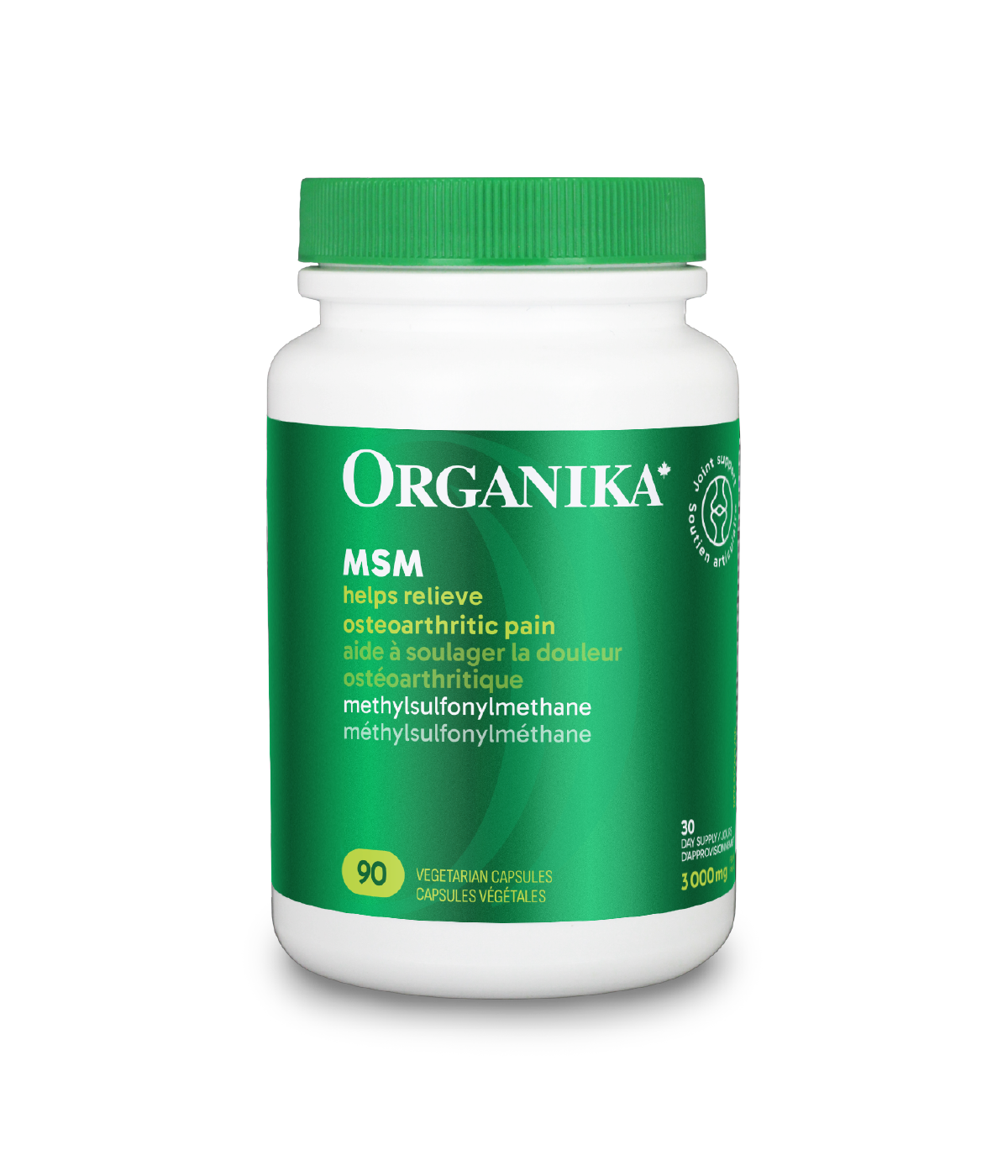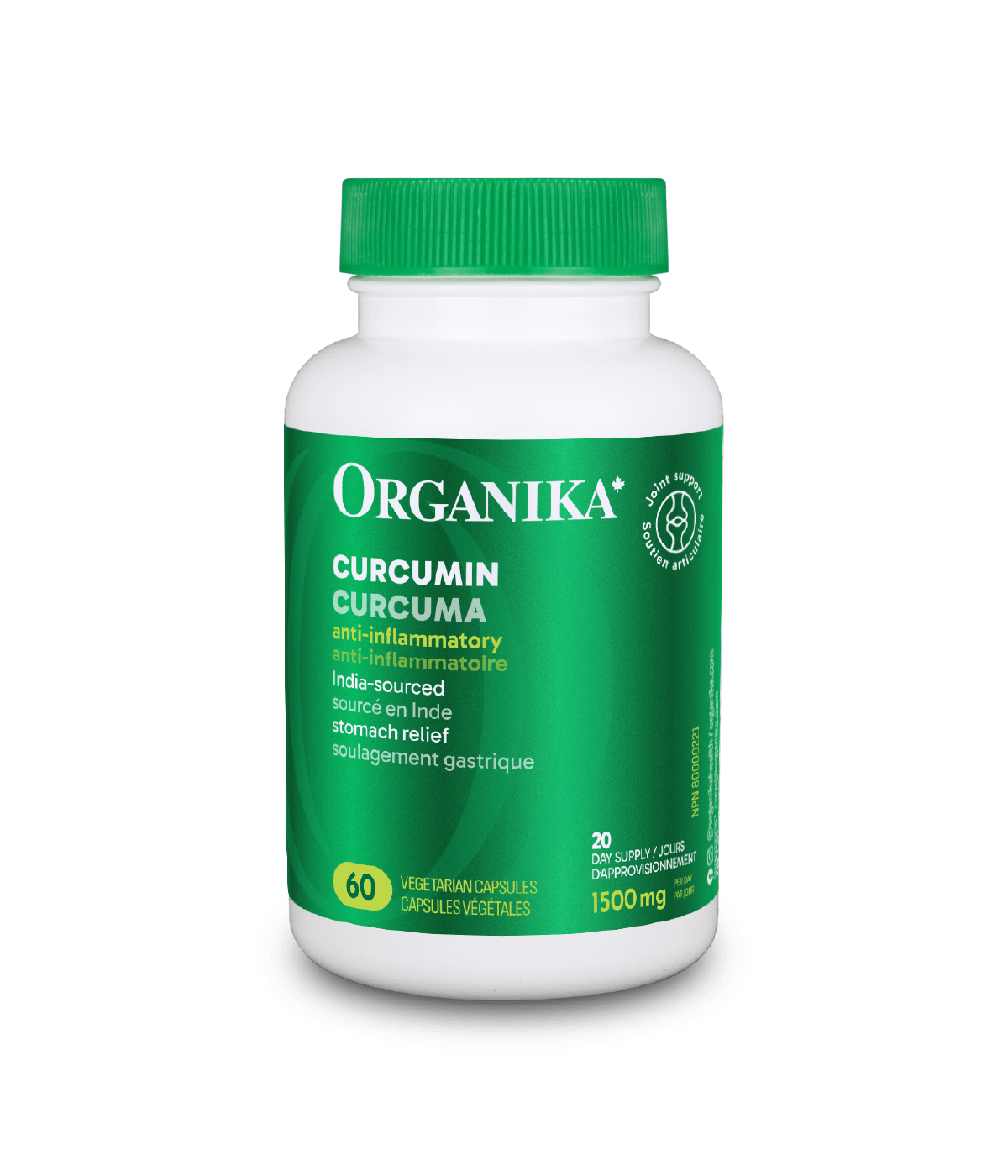








-
BestsellerIs this right for you?

-


-


-

-

-

-

Enhanced Collagen Protein Bone & Joint
Ease pain, fight inflammation and protect your bones and joints
- May help reduce the risk of osteoporosis
- Reduces joint pain associated with osteoarthritis
- Supports cartilage, bone and connective tissue health
- Aids in collagen formation and tissue repair
Impossible de charger la disponibilité du service de retrait



Notify Me When Available
Enter your email and we'll let you know as soon as this product is back
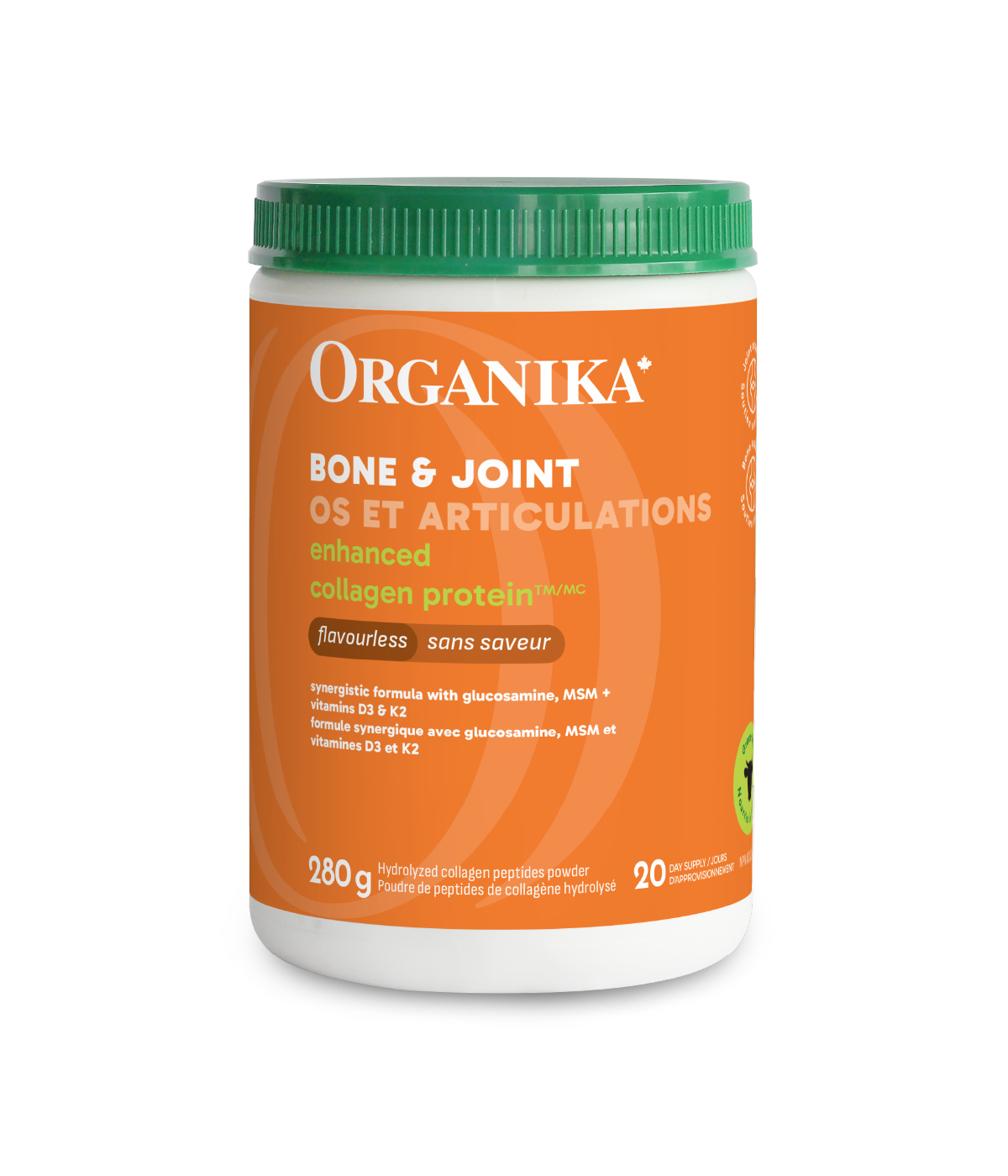

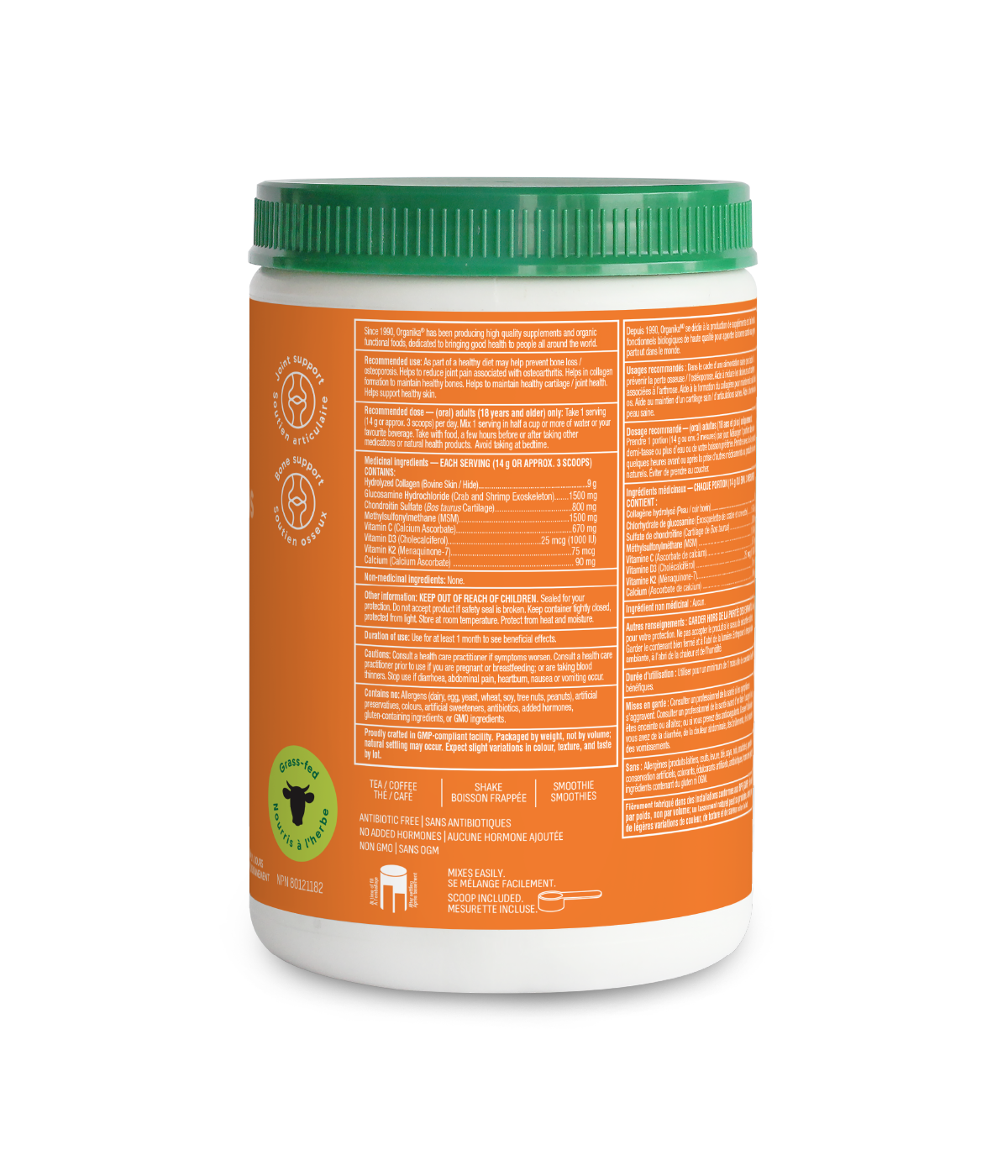
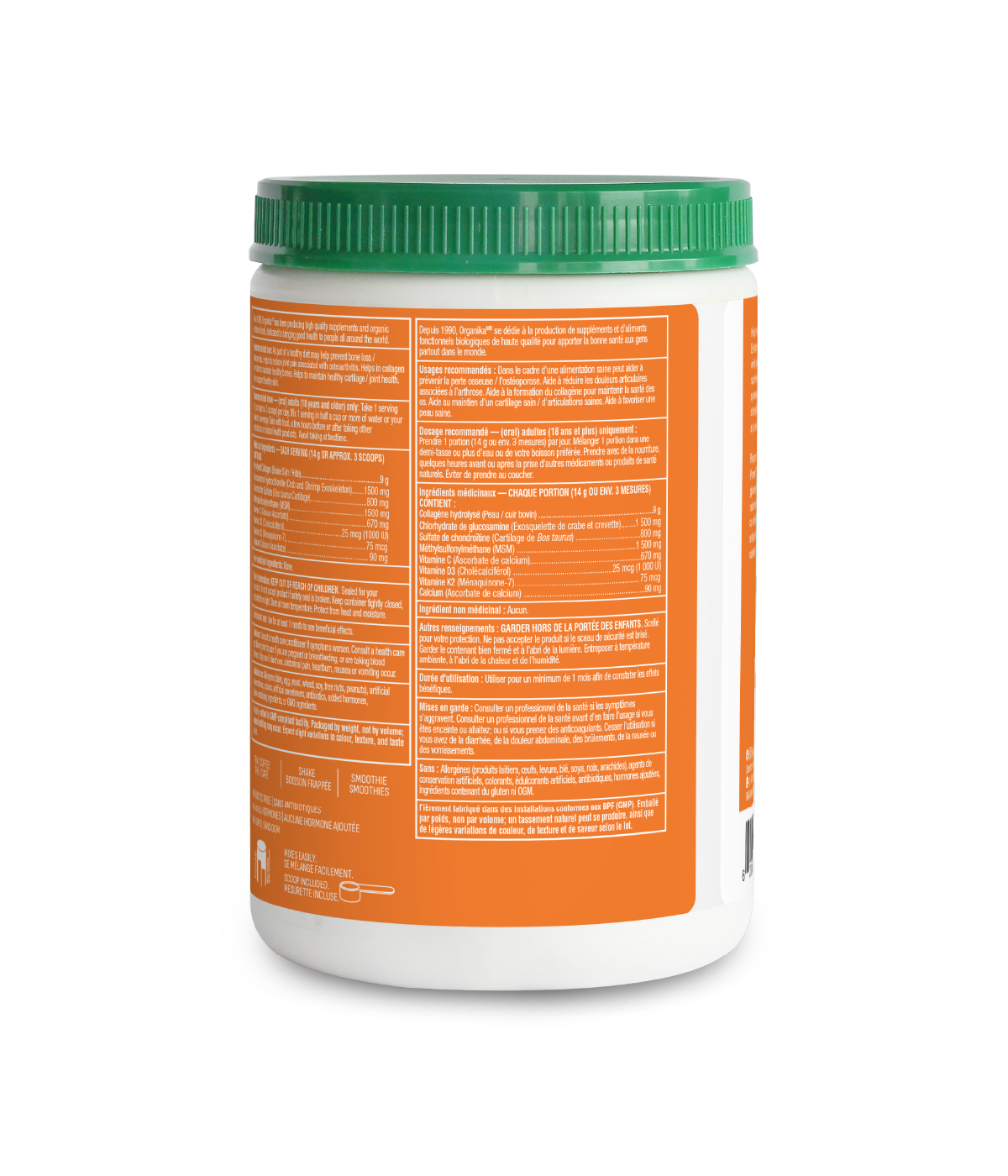
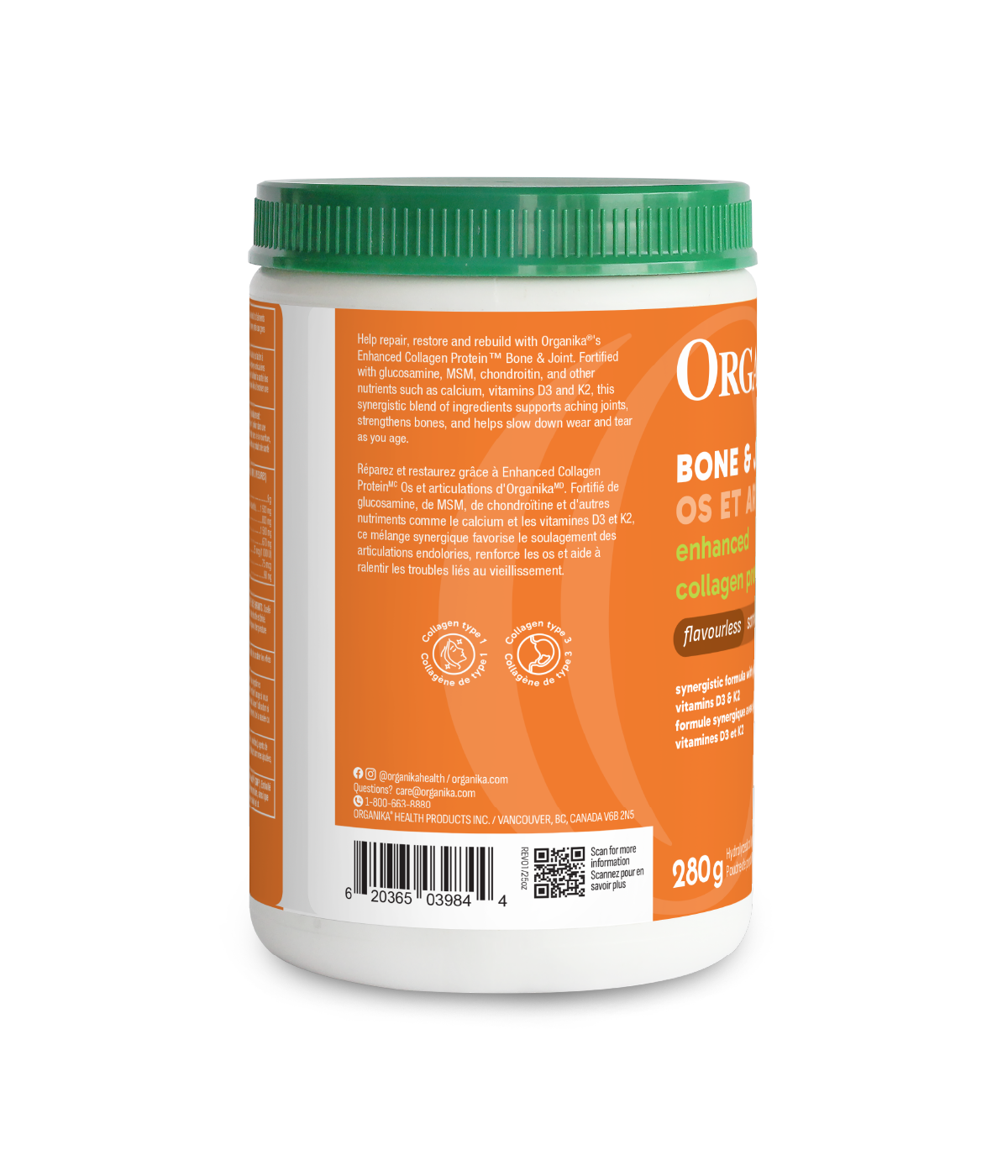





Supplement Facts





Ingredients & Nutrition
MEDICINAL INGREDIENTS — EACH SERVING (14 g OR APPROX. 3 SCOOPS) CONTAINS: Hydrolyzed Collagen (Bovine Skin / Hide) 9 g, Glucosamine Hydrochloride (Crab and Shrimp Exoskeleton) 1500 mg, Chondroitin Sulfate (Bos taurus Cartilage) 800 mg, Methylsulfonylmethane (MSM) 1500 mg, Vitamin C (Calcium Ascorbate) 670 mg, Vitamin D3 (Cholecalciferol) 25 mcg (1000 IU), Vitamin K2 (Menaquinone-7) 75 mcg, Calcium (Calcium Ascorbate) 90 mg
Recommended dose — (oral) adults (18 years and older) only: Take 1 serving (14 g or approx. 3 scoops) per day, mix 1 serving in half a cup or more of water or your favourite beverage, take with food, a few hours before or after taking other medications or natural health products, avoid taking at bedtime.
Is This Right for You?
Are you dealing with joint pain or stiffness?
Do you want to maintain strong bones and cartilage?
Are you looking for a collagen powder that fits easily into your routine?
Are you after clean, effective support?
If you answered ''yes'' to any of the above, this product is right for you.

-
Supports cartilage, bone and connective tissue health
-
Aids in collagen formation and tissue repair
Ingredients & Nutrition
Recommend For
Are you dealing with joint pain or stiffness?
Do you want to maintain strong bones and cartilage?
Are you looking for a collagen powder that fits easily into your routine?
Are you after clean, effective support?
If you answered ''yes'' to any of the above, this product is right for you.
Gluten-Free
Egg-Free
Keto Friendly
No Preservatives
Non-GMO
Dairy-Free
This blend goes beyond basic collagen by combining hydrolyzed collagen peptides with proven joint-support nutrients


The Full Scoop

-
Supports cartilage, bone and connective tissue health
-
Aids in collagen formation and tissue repair
This isnít your average collagen powder. Enhanced Collagen Protein Bone & Joint has targeted nutrients that support how your body feels and moves every day. On top of hydrolyzed collagen, we layer in glucosamine, chondroitin, MSM, calcium, vitamin D3, K2, and collagen shown to help ease joint pain and keep your bones strong. This synergistic blend of ingredients is helpful for supporting a healthy frame as you age, move and slow down joint wear and tear. It's especially effective for people managing osteoarthritis, stiffness, or age-related bone loss.
"Love this product. Has really helped me with my osteoarthritis. Highly recommend it."
Verified Buyer
Ask Away
We’ve got the FAQs covered. But if you’re still stuck, we’re only a message away.
Get in TouchWhen should I use this product?
We recommend adding it to your daily routine so that you're consuming it consistently at a time convenient to you (morning, post-workout, etc).
How is this different from your other collagen products?
Enhanced Collagen is a bovine-sourced hydrolyzed collagen supplement containing type 1 and type 3 collagen. This is a blend of our collagen PLUS ingredients that are focused on decreasing joint and muscle pain, as well as helping reduce inflammation and prevent cartilage breakdown.
Who is this product intended for?
Enhanced Collagen Protein Bone & Joint is intended for active adults, anyone concerned with joint or muscle pain, as well as those with osteoarthritis. Due to its high protein content, this product is great for those following a keto diet.
Can I take this long-term?
Yes, this blend is suitable to take on an on-going basis. We recommend taking it for a minimum of 4-6 weeks to start seeing results.
It says take one serving- is the serving a scoop or a suggested amount in grams?
Yes, each serving is 14 g (approximately 3 scoops).
Can I use this in hot beverage/food?
Yes, the blend works with hot and cold items. Note: there is vitamin C which is normally destroyed by heat, however it's only present due to using a specific form of calcium (calcium ascorbate) and not in an amount to be counted as a significant source.
You'll Likely Also Love...
Liga-Joint Premium
Move with ease and maintain healthy joints
Chicken Bone Broth Protein Powder
All the chicken bone broth benefits, none of the stovetop hassle
MSM
A sulphur-rich essential for joint comfort, muscle recovery and inflammation balance
Curcumin
Relieve aches and pains with turmericís most active compounds
Support Beyond Products
How to exercise using joint protection techniques Suffering from joint pain can leave you questioning your ability to exercise and stay physically fit. That’s why making sure to exercise with joint protection techniques in mind is so important. Your joints need strong muscles to help support them. Moving your body increases the flexibility of your joints and reduces the stiffness. If you suffer from joint pain, moving the right way for your body can help to improve your performance and overall health. 1. Choose low impact activities Choosing the right types of aerobic exercise, strength training and range of motion movements can go a long way when trying to accommodate joint pain. Low impact exercises are activities that are easier on the body, reduce the risk of injury and provide less stress to your joints. Swimming, cycling, yoga, and walking are some examples of low impact movements that can be more accommodating to joint pain and arthritis. 2. Cross train Mixing up your routine with a few different forms of exercise is great for your body. Cross training helps your body to train different muscle groups through different movements, increasing your strength and performance overall. Cross training is also a great way to stay engaged in being active, preventing you from become bored. 3. Take rest days Giving your joints and muscles a rest can help them to repair and strengthen. Overworking your body increases the risk of injury. Schedule rest days in your weekly routine to give your body time to recuperate. 4. Warm up Doing a gentle warm up session such as going for a walk can help to warm your muscles and prepare them for exercise. Warm muscles are more flexible which helps to reduce the measure of strain they go through during a workout. 5. Don’t overdo it If you’re feeling pain, or find you have long periods of pain after a workout, you’re likely overdoing it. Some mild pain may be normal if you’re not used to working out, but the pain shouldn’t be debilitating. Keep your level of exertion relative to your level of fitness. 6. Drink lots of water Hydration is important for overall health, and that includes your joints. Make sure you drink plenty of water when exercising. The more you sweat the more you need to replenish your body with fluids. 7. Wear the right attire Wearing the right kind of fitness attire for the sport you’re practicing, encourages proper range of motion for healthy joint movement. Don’t restrict your movements from clothing too tight or stiff to move with your body. 8. Cool down Take a period of time to slow your exertion near the end of your routine to allow your body to cool down. Always follow your exercises up with light stretching to help reduce feelings of stiffness the next morning. Most importantly, always remember to listen to your body. If you’re in a lot of pain, or are going through an injury, certain exercises might be more harmful than healthy. Always talk to your doctor before starting a new exercise routine, and consider consulting a physical therapist if you’re dealing with severe joint pain. What kind of exercise do you do?
read moreDon’t let gout pain keep you down, exercise is good for your joints Making exercise a part of your routine might sound crazy if you deal with gout pain. And while exercise isn’t recommended during an acute gout attack, making time for movement in your average weekly routine is definitely still important. Gout is a type of arthritis that causes inflammation in the joints, with acute attacks of sharp paining and swelling. Like other types of arthritis (osteo- or rheumatoid), gout contributes to the deterioration of joint tissue that can disrupt your life. But, letting your joint pain prevent you from exercising can actually be counterproductive overtime. Your joints need strong muscles to help support them. Making time to move your body also increases the flexibility of your joints, and reduces the stiffness. Exercise can also improve your quality of sleep, energy levels and support bone health. It even helps with weight management, which can help to reduce the risk of gout flare-ups. Whether you’re a fairly active person already or more sedentary type, exercising with arthritis is all about finding the right low-impact activities at the right intensities for your body. The 3 Types of Exercise You Want to Include There are different types of exercise that provide different benefits to your health. The perfect balance is including a bit of each type in your routine. 1. Range of Motion Exercise Range of motion exercises include stretching and flexibility movements that help to maintain your joints full range of function. They’re simple exercises that can safely be done on a daily basis. They help to prevent stiffness and improve flexibility and strength within the joint. Simple movements include rolling your shoulders back or moving your head from front to back to side to side. 2. Aerobic Exercise Aerobic exercise, otherwise referred to as cardio exercise, is what gets your heart rate up and improves stamina and energy. It’s great for cardiovascular health, and even stress reduction. You might first and foremost think running when you think about cardio, but there are many other activities that count as aerobic exercise as well. Running can actually be quite high-impact on knee joints, so if you deal with arthritic pain in your knees try opting for something more low impact. Walking, biking and swimming are all examples of low-impact ways to get your aerobic exercise in. 3. Strength Training Strength training is a form of exercise that uses resistance to improve strength and muscle. Muscular strength can help to support the integrity of the joint. The stronger the muscles surrounding the joints are, the less shock the cartilage of the joint is exposed to. Strength training exercises can be done using the machines at a gym, or performed simply in the comfort of your home by purchasing a couple of weights or resistance bands. Strength training can also include body weight exercises such as push-ups or planks, that use the weight of your own body as the resistance factor. Having proper form when strength training is key in order to get the most from your exercise, while also preventing injury. If you’ve never done any weight baring exercise before, taking a couple of personal training sessions can help you to learn proper form and exercises suitable for your condition. Once you start exercising, make sure you leave time for your body to recover between workouts. Avoid exercising the same muscle groups day after day in a row, and start slow. If you’re feeling a lot of pain during or after exercising, you’re likely overdoing it. Staying active is an important part of managing the pain that comes with gout and other types of arthritis. One of the best things you can do when it comes to incorporating exercise into your weekly routine is finding something that you truly love to do. Go for walks with a friend, try a yoga class or head out on a hike. Remember, exercise doesn’t need to be intense. Even day to day activities like mowing the lawn or taking the stairs count towards keeping your joints active. Remember to talk to your healthcare practitioner before starting a exercise routine. Your doctor can help suggest exercises for your condition, plus tell you how much intensity is safe for your current state of fitness! What's your favourite type of exercise References: http://goutandyou.com/gout-and-exercise/ http://www.arthritis.org/living-with-arthritis/exercise/benefits/exercise-knee-osteoarthritis.php http://www.mayoclinic.org/arthritis/art-20047971?pg=1 https://consumer.healthday.com/encyclopedia/arthritis-3/demographic-arthritis-news-37/weightlifting-and-arthritis-645281.html
read moreJoint pain can be debilitating and affect people of all ages, whether it's due to osteoarthritis, aging, or high levels of physical activity. Recently, collagen powder has emerged as a popular supplement to support joint health. But does it actually work for alleviating joint pain? Let's dive into the science behind collagen and its potential benefits for joint health. What Is Collagen? Collagen is the most abundant protein in the human body, responsible for maintaining the structural integrity of skin, bones, tendons, and joints. As we age, collagen production declines, contributing to joint discomfort, cartilage deterioration, and other age-related issues. This has led to interest in collagen supplements, especially hydrolyzed collagen powder, which is broken down into smaller peptides that are easier for the body to absorb. Collagen and Joint Health Cartilage—the cushioning material in joints—is made up largely of collagen. Loss of cartilage can cause joint pain and stiffness, common symptoms in osteoarthritis. Supplementing with collagen has been proposed as a way to restore some of this lost cartilage, potentially reducing joint pain and improving mobility. Check out Organika’s Enhanced Collagen Bone & Joint supplement, which contains MSM, chondroitin, glucosamine, and vitamin D3, all designed to support joint health. What Does Research Say About Collagen for Joint Pain? Several studies suggest that collagen supplementation may offer benefits for people experiencing joint pain, particularly related to osteoarthritis and sports injuries. Osteoarthritis Relief: Research suggests that collagen supplements may help alleviate joint pain associated with osteoarthritis. A review of clinical studies concluded that oral collagen supplementation is reasonably effective for reducing pain in people with osteoarthritis, though more research is necessary to fully understand its efficacy (Woo et al., 2017). Joint Pain in Athletes: Athletes who experience joint pain from repetitive strain or injury may also benefit from collagen. A 12-week trial found that athletes who took specific collagen peptides experienced a significant reduction in activity-related knee pain compared to those who took a placebo (Zdzieblik et al., 2017). Similarly, a study on athletes with activity-related joint pain showed that supplementing with collagen hydrolysate over 24 weeks improved measures of joint pain and discomfort (Clark et al., 2008). Hydrolyzed Chicken Collagen: One randomized trial focused on healthy adults with joint discomfort found that hydrolyzed type II chicken collagen significantly reduced joint pain and improved joint function (Mohammed & He, 2021). The participants reported improved mobility and reduced stiffness, highlighting collagen's potential for supporting joint health even in people without diagnosed conditions like osteoarthritis. How Does Collagen Work for Joint Pain? Consuming Organika's collagen is simple, enjoy it with hot or cold beverages, you can even bake wit it. When you consume hydrolyzed collagen it is broken down into smaller peptides that the body can absorb. These peptides may accumulate in cartilage, stimulating your body’s own production of collagen and other components necessary for maintaining healthy joints. This process helps to: Promote Cartilage Repair: Collagen supplements provide the building blocks necessary to support the repair of damaged cartilage, which may improve joint cushioning. Reduce Inflammation: Collagen has been shown to reduce inflammation in the joints, which can lead to pain relief in conditions like osteoarthritis. Improve Joint Lubrication: Some evidence suggests that collagen can help increase the amount of synovial fluid, which lubricates the joints, making movement smoother and less painful. Organika’s Enhanced Collagen Pure Beauty contains 120 mg of Hyaluronic Acid which is fantastic at providing moisture specifically to the synovial fluid in the joints, the eyes and the skin. Controversy Around Collagen for Rheumatoid Arthritis While collagen appears to be promising for osteoarthritis and sports-related joint pain, its effectiveness for rheumatoid arthritis remains controversial. Rheumatoid arthritis (RA) is an autoimmune condition where the body attacks its own joint tissue, and current research has not conclusively shown collagen supplementation to be beneficial for RA sufferers. According to Woo et al. (2017), the benefits of collagen for RA are still unclear and require further investigation. Types of Collagen for Joint Health There are different types of collagen, but type II collagen (found in Organika’s Chicken Bone Broth Protein Powder, Full Spectrum Collagen 1, 2, 3, 5, 10, and Biocell Collagen Capsules) is most commonly associated with joint health because it is found in cartilage. Many collagen supplements, especially those marketed for joint pain, contain hydrolyzed type II collagen derived from chicken or bovine sources. However, blends that include other types, such as types I and III, may provide additional benefits for skin, tendons, and ligaments. How to Take Collagen Powder for Joint Pain Collagen powder is easy to incorporate into your routine—simply mix it into water, smoothies, or coffee. For joint health benefits, studies typically suggest taking 5 to 10 grams of collagen per day over a period of at least 8 to 12 weeks. Organika’s new Lemon Enhanced Collagen Protein is a quick and tasty way to get all the benefits, just add cold water, sip and enjoy. Potential Side Effects Collagen is generally considered safe for most people, with minimal side effects reported. Some individuals may experience mild digestive symptoms like bloating, but these effects are rare. As always, it's a good idea to consult with a healthcare provider before starting any new supplement, especially if you have pre-existing health conditions. Conclusion: Can Collagen Help with Joint Pain? Based on current research, collagen powder shows promise for reducing joint pain, particularly in cases of osteoarthritis and physical activity-related discomfort. Studies have demonstrated that collagen supplementation can improve cartilage health, reduce inflammation, and support overall joint function. While it may not be a magic bullet, collagen could be a valuable addition to your joint care routine. For those struggling with joint pain, consistent use of collagen powder may help alleviate symptoms and promote better mobility over time. However, more research is needed, especially for conditions like rheumatoid arthritis, to fully understand collagen’s role in managing joint pain. References Clark, K. L., et al. (2008). 24-Week study on the use of collagen hydrolysate as a dietary supplement in athletes with activity-related joint pain. Current Medical Research and Opinion, 24(5), 1485-1496. Woo, J., et al. (2017). Oral collagen supplementation for osteoarthritis: A systematic review. The Journal of Arthritis, 6(1), 1-9. Zdzieblik, D., et al. (2017). Collagen peptide supplementation reduces activity-related joint pain in young adults. Journal of the International Society of Sports Nutrition, 14(30). Mohammed, S., & He, J. (2021). Hydrolyzed chicken collagen type II improves joint discomfort in healthy adults: A randomized controlled trial. International Journal of Rheumatic Diseases, 24(3), 305-310.
read more





